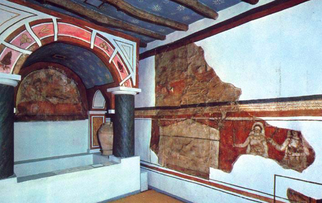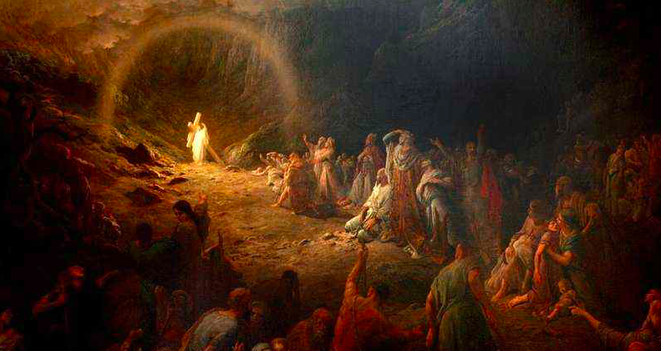I am working on and preparing for Sunday's sermon (2/25/18)–one of the hardest passages in the NT, 1 Peter 3:18-22. Nonetheless, there is, in this tough, baffling text, the secret, the mystery for how the early church changed things and how it, with no power or leverage or prestige scared the living day-lights out of Caesars and the Roman empire–and still, today, can change things now . . . here's a preview . . . and some basic, preliminary thoughts . . . First, let's stick with what is clear from this most enigmatic of NT texts:
And, then, second, this text is good news to the church, to believers in that . . .
It is amazing that this small, embattled church made up of unequals and strangers, should have scared or alarmed anyone, especially those in power. Yet, it did. We, today, are quite harmless–this is perhaps why so many Christian social justice advocates and, as well, Christian conservatives rely on the government (i.e., earthy power) to do justice and enforce (always through some form of violence and/or punishment related actions) justice. I believe our lose of the power God gives his church, his local gathered-church has been lost because we hate the idea of suffering (like Jesus) and so want the acceptance and comfort our earthly powers grants us–as individual believers and as local gathered-churches. Here is my thought on the significance of this text in 1 Peter. And by "in," I mean in the flow and thought of Peter's Letter to the "elect exiles of the dispersion in Pontus, Galatia, Cappadocia, Asia, and Bithynia" (1:1b):
0 Comments
 Leveling Habits: The Table, Household Baptism, and Kiss that Changed Everything (B) Baptisms. Samaritan “men and women,” an Ethiopian eunuch, the oppressing-Christian-killing Saul, a military Gentile, a Gentile (single?) woman (and “her household”), a Gentile jailor (and “his household”), and an outlier, Corinthian Jew with a Gentile name, Crispus (and “all of his household”) are Luke’s narrative choices of “baptism” stories. Of course, there are multitudes more, but when Luke has a chance to write about baptisms, these are the ones he chose for us to know. In fact, the first time he mentions anyone being baptized after the initial Pentecost events, it is Samaritan “men and women” (8:9; 12).[1] And, the first time Luke tells of an individual that is baptized, it is a foreign eunuch, serving a pagan king (8:36–8). What are Luke’s narrative choices embedded in the “church” story telling us about “church”? The baptism habitus of the gathered-church amid the deipnon (Lord’s Supper) moved people of unequal social status into being “one in Christ” as individuals and as households (which included women, children, and slaves) amid intimacy, reclining among unequals, the risk of being seen as a treasonous gathering (for at a deipnon there were on-lookers), celebrating the death of a traitor acknowledged as Lord and Head of the new social group. Household baptism (along with Luke’s other narrative choices) displayed the counter-cultural and, thus, seditious nature of a gathered-church. This is further seen in NT cross-related texts, that is, trajectory application regarding the unequal “mix” of who made up the gathered-church. Paul links the reconciliation of Jews and Gentiles as a trajectory application of the cross: But now in Christ Jesus you who formerly were far off have been brought near by the blood of Christ. For He Himself is our peace, who made both groups into one and broke down the barrier of the dividing wall, by abolishing in His flesh the enmity, which is the Law of commandments contained in ordinances, so that in Himself He might make the two into one new man, thus establishing peace, and might reconcile them both in one body to God through the cross, by it having put to death the enmity (Eph 2:13–16). This reconciliation, wherein “the both” are created “one new humanity” (v. 15c),[2] is directly related to the nature of the church: “the both” are fellow citizens of God’s household that is growing into a holy temple in the Lord, being built together into a dwelling of God in the Spirit (vv. 19–22). The unequal-oneness is the trajectory application of the death of Jesus. Later, Paul calls the church to unity through the imagery of its “one baptism” (4:5). Paul associates baptism with Christ’s death: Or do you not know that all of us who have been baptized into Christ Jesus have been baptized into His death? (Rom 6:3).[3] This is important, for Paul, then, links baptism to the nature of the gathered-church. The Colossian believers, Paul writes, have been buried with Christ “in baptism” (2:12a) and as a result, they are to set their minds on things above where Christ is seated at the right hand of God (3:1). This is directly related to the Colossian gathered-church’s identity: Do not lie to one another since the old man is laid aside with its practices and the new [man] is put on that is being renewed into the image according to the one who created it, where no Greek and Jew is, that is (kai) [where there is no] circumcised and uncircumcised, barbarian, Scythian, slave, freeman, but all things and in all is Messiah [my translation] (3:9-11). The setting is most certainly the deipnon (cf. 3:12–16) and the letter itself most assuredly was read at the after-meal symposium. Furthermore, in other passages Paul links baptism habitus to the associations within the gathered-church: For by one Spirit we were all baptized into one body, whether Jews or Greeks, whether slaves or free, and we were all made to drink of one Spirit (1 Corinthians 12:13). The gathered-church exists where unequals are present (and welcome) and there is no ethno-centric center of power. Furthermore, this cross/baptism-nature of church is applied to the gathered-church in Corinth regarding the Lord’s Supper and offers more support for a better reading of the Corinthian “table” issue (1 Cor 11). Paul links their baptism as a sign of their oneness (i.e., one body, 1 Cor 12:13a) and, then made trajectory application of whether Jews or Greeks, whether slaves or free, and we were all made to drink of one Spirit (v. 13b) to the issues experienced at the meal/table (i.e., the deipnon). Participation in the Lord’s Supper (the habitus) is itself to be proclamation of Messiah’s death (v. 26, For as often as you eat this bread and drink the cup, you proclaim the Lord’s death until He comes), but was not so in the divisions made at the deipnon food habitus: . . . when gathering together as church, I hear that divisions exist among you . . . Therefore when gathering together, it is not to eat the Lord’s Supper [deipnon] (vv. 18, 20; my translation). [1] My italics to emphasize the inclusion of Samaritan (which is itself impacting) women being baptized. [2] NIV (2011). [3] See Rom 6:4: We were buried therefore with him by baptism into death, in order that, just as Christ was raised from the dead by the glory of the Father, we too might walk in newness of life. This is a thread consisting of parts of a a recent paper presented at the 2017 Evangelical Theological Society's annual meeting in Providence, RI. The goal is to develop an anthology of essays (by various authors) on the subject, Christian Responses to Tyranny. Part 1 | Part 2a | Part 2b | Part 2c | Part 3 | Part 3a | Part 3b | Part 4a | Part 4b | Part 5 For the entire thread (remember to scroll backwards for previous posts) << Gathered-church >>
|
AuthorChip M. Anderson, advocate for biblical social action; pastor of an urban church plant in the Hill neighborhood of New Haven, CT; husband, father, author, former Greek & NT professor; and, 19 years involved with social action. Archives
February 2024
Categories
All
|
Pages |
More Pages |
|

 RSS Feed
RSS Feed